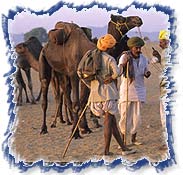
It was Akbar the Great who built the fort here to suppress the Rajput rulers of the state. "The fort was used by Akbar to plan the war strategy for the battle of Haldhghati against Maharana Partap of Udaipur" said a historian According to him, Swai Mansingh of Jaipur leaded the battle of haldighati against Maharana Partap. The fort is important for turist as they come to witness the architecture and craft importance of Rajput Mugal collaboration.
Beside the fort the museum in the fort also attracts the tourists. "Mainly tourists want to know the place from where the permission was granted to Sir Tomas of East India Company and we show them the window of the fort" said Manak Kumar, a tourist guide. He said that even domestic tourists are interested to know the history of this fort as it played important role in the history of India.
"We are going to open the audience hall of the fort from 22 December" said Sayed Ajam Hussein, deputy director of archeological department and executive curator of Museum. He said that work of innovation would continue in other part of the fort.
The museum has the treasure of ancient statues belonging to Jain and Bodh scriptures. "There are the statues dating long back to 2 century BC" said sources. There are also written scriptures and in scripts found from the Pushkar region. "The importance of this museum is also signifies the development of Ghandar, Mugal and Rajasthani sculpture in different period of time" said Hussein. The statues also show the great work and development of stone to metal and copper in the sculpture.
Source: http://timesofindia.indiatimes.com/Jaipur


 The shops in the market around the Dargah sell flowers, prayer mats, rosaries, textiles, and general merchandise as well. Ajmer is 132 kms. south-west of Jaipur and 198 kms. east of Jodhpur. It is connected by road to Jaipur, Jodhpur, Bikaner, Udaipur and Kota. Ajmer is a railway junction on the Delhi-Ahmedabad section of the Western Railway. During the Urs, special buses ply from cities all over India carrying people to Ajmer and back.
The shops in the market around the Dargah sell flowers, prayer mats, rosaries, textiles, and general merchandise as well. Ajmer is 132 kms. south-west of Jaipur and 198 kms. east of Jodhpur. It is connected by road to Jaipur, Jodhpur, Bikaner, Udaipur and Kota. Ajmer is a railway junction on the Delhi-Ahmedabad section of the Western Railway. During the Urs, special buses ply from cities all over India carrying people to Ajmer and back. The Pink City of India, the royal capital of Rajasthan, Jaipur was built by Maharaja Sawai Jai Singh in 1727 AD. The ancient heart of this regal city still beats in its fairy tale palaces, its magnificent fortresses perched on barren hills, and in the broad avenues that provide a superb transport network throughtout the city.
The Pink City of India, the royal capital of Rajasthan, Jaipur was built by Maharaja Sawai Jai Singh in 1727 AD. The ancient heart of this regal city still beats in its fairy tale palaces, its magnificent fortresses perched on barren hills, and in the broad avenues that provide a superb transport network throughtout the city.